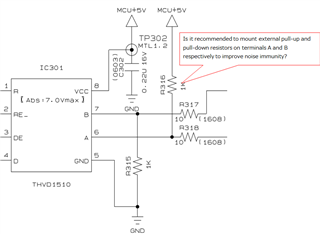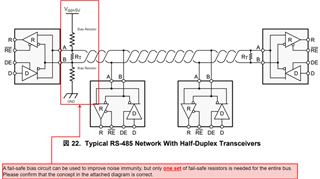Tool/software:
We are considering mounting an external fail-safe bias circuit for the THVD1510 as shown in the attached figure. Specifically, the purpose is the following two points.
(1) To prevent the receiver output from being undefined in the bus idle state as a fail-safe measure when open.
(2) To improve noise immunity by constantly flowing drive current to +200mV or more to fix the bus line logic to High even when all transceiver ICs connected to the bus line are in the receive state.
However, the number of units that can be connected to the bus is limited by the pull-up and pull-down resistor values, so we need to consider the constants. (The constants will be considered in the future.) If there are any adverse effects or concerns with this circuit configuration, please let us know.
Regards,
Kagawa


